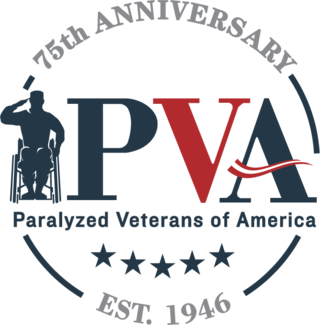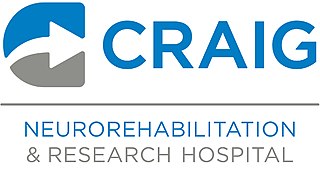Related Research Articles

Richard Marvin Hansen is a Canadian track and field athlete, activist, and philanthropist for people with disabilities. Following a pickup truck crash at the age of 15, Hansen sustained a spinal cord injury and became a person with paraplegia. Hansen is most famous for his Man in Motion World Tour, in which he circled the globe in a wheelchair to raise funds for charity. He was inducted into Canada's Sports Hall of Fame in 2006. He was one of the final torchbearers in the 1988 Winter Olympics and the 2010 Winter Olympics. He was profiled and spoke during the 2010 Winter Paralympics opening ceremony.

A spinal cord injury (SCI) is damage to the spinal cord that causes temporary or permanent changes in its function. Symptoms may include loss of muscle function, sensation, or autonomic function in the parts of the body served by the spinal cord below the level of the injury. Injury can occur at any level of the spinal cord and can be complete, with a total loss of sensation and muscle function at lower sacral segments, or incomplete, meaning some nervous signals are able to travel past the injured area of the cord up to the Sacral S4-5 spinal cord segments. Depending on the location and severity of damage, the symptoms vary, from numbness to paralysis, including bowel or bladder incontinence. Long term outcomes also range widely, from full recovery to permanent tetraplegia or paraplegia. Complications can include muscle atrophy, loss of voluntary motor control, spasticity, pressure sores, infections, and breathing problems.

Thomas Joseph Pashby was a Canadian ophthalmologist and sport safety advocate. He spent 46 years improving the safety of hockey helmets to prevent injuries in ice hockey, by developing visors and wire face masks, and advocating for neck protection on goaltender masks. He served two decades as chairman of the Canadian Standards Association (CSA), setting standards for manufacturers of hockey and lacrosse helmets.

Toronto Rehabilitation Institute is the largest rehabilitation hospital in Canada. Owned and operated by the University Health Network (UHN), Toronto Rehab provides patients with rehabilitation care, helping people rebuild their lives and achieve individualized goals following injury and disability. It is composed of five sites across Toronto, which are: Bickle Centre, Lakeside Centre, Lyndhurst Centre, Rumsey Centre, and University Centre.
The Christopher & Dana Reeve Foundation is a charitable organization headquartered in Short Hills, New Jersey, dedicated to finding treatments and cures for paralysis caused by spinal cord injury and other neurological disorders.

A spinal cord stimulator (SCS) or dorsal column stimulator (DCS) is a type of implantable neuromodulation device that is used to send electrical signals to select areas of the spinal cord for the treatment of certain pain conditions. SCS is a consideration for people who have a pain condition that has not responded to more conservative therapy. There are also spinal cord stimulators under research and development that could enable patients with spinal cord injury to walk again via epidural electrical stimulation (EES).

The Paralyzed Veterans of America is a veterans' service organization in the United States of America, founded in 1946. The organization holds 33 chapters and 70 National Service Offices in the United States and Puerto Rico. It is based in Washington, D.C. The organization was founded in 1946 by a band of service members who came home from World War II with spinal cord injuries. These service members wanted to live with independence and dignity and as contributors to society, so they created the organization to be governed by its members, veterans of the armed forces living with spinal cord injury or disease such as multiple sclerosis (MS) and amyotrophic lateral sclerosis (ALS), also known as Lou Gehrig’s disease.

Craig Hospital is a neurorehabilitation and research hospital in Englewood, Colorado specializing in spinal cord injury (SCI) and traumatic brain injury (TBI) rehabilitation and research. Craig is a 93-bed, private, not-for-profit, free-standing long-term acute care and rehabilitation hospital that provides a comprehensive system of inpatient and outpatient medical care, rehabilitation, neurosurgical rehabilitative care, and long-term follow-up services. Half of Craig's patients come from outside of Colorado each year, and in the past four years Craig has treated patients from all 50 states and several foreign countries. At any given time, the staff at Craig treats approximately 55 inpatients with spinal cord injuries, 30 with traumatic brain injuries, and 50-60 outpatients. Craig provides housing for out-of-state families and outpatients, including the first 30 days free for families of new inpatients.
Spinal Cord Injury BC is a not-for-profit organization that helps people with spinal cord injuries and related injuries adjust, adapt and thrive by providing answers, information and community experiences in the Canadian province of British Columbia.
MedStar National Rehabilitation Network is located in Washington, D.C., and specializes in treating persons with physical disabilities, including spinal cord injury, brain injury, stroke, arthritis, amputation, multiple sclerosis, post-polio syndrome, orthopedic, and other neurological conditions. National Rehabilitation Hospital was founded in 1986 by Edward A. Eckenhoff, and is a member of the MedStar Health system, the Washington, D.C.-Baltimore region's largest non-profit healthcare organization.

The Kennedy Krieger Institute is a nonprofit, 501(c)(3) tax-exempt, Johns Hopkins affiliate located in Baltimore, Maryland, that provides in-patient and out-patient medical care, community services, and school-based programs for children and adolescents with learning disabilities, as well as disorders of the brain, spinal cord, and musculoskeletal system. The Institute provides services for children with developmental concerns mild to severe and is involved in research into various disorders, including new interventions and earlier diagnosis.
The Sam Schmidt Paralysis Foundation (SSPF) is a charitable organization founded in 2000 and headquartered in Pennington, New Jersey.
When treating a person with a spinal cord injury, repairing the damage created by injury is the ultimate goal. By using a variety of treatments, greater improvements are achieved, and, therefore, treatment should not be limited to one method. Furthermore, increasing activity will increase his/her chances of recovery.
A catastrophic injury is a severe injury to the spine, spinal cord, or brain. It may also include skull or spinal fractures. This is a subset of the definition for the legal term catastrophic injury, which is based on the definition used by the American Medical Association.

Although spinal cord injury (SCI) often causes sexual dysfunction, many people with SCI are able to have satisfying sex lives. Physical limitations acquired from SCI affect sexual function and sexuality in broader areas, which in turn has important effects on quality of life. Damage to the spinal cord impairs its ability to transmit messages between the brain and parts of the body below the level of the lesion. This results in lost or reduced sensation and muscle motion, and affects orgasm, erection, ejaculation, and vaginal lubrication. More indirect causes of sexual dysfunction include pain, weakness, and side effects of medications. Psycho-social causes include depression and altered self-image. Many people with SCI have satisfying sex lives, and many experience sexual arousal and orgasm. People with SCI may employ a variety of adaptations to help carry on their sex lives healthily, by focusing on different areas of the body and types of sexual acts. Neural plasticity may account for increases in sensitivity in parts of the body that have not lost sensation, so people often find newly sensitive erotic areas of the skin in erogenous zones or near borders between areas of preserved and lost sensation.
Michael Fehlings is a Canadian neurosurgeon based at Toronto Western Hospital in Toronto, Ontario, Canada. Dr. Fehlings specializes in complex spine surgery with a special interest in traumatic and non-traumatic spinal cord injury and spine oncology. He mainly focuses on preclinical and clinical translational research related to enhancing repair and regeneration of the injured central nervous system. He holds many positions, including Head of the Spinal Program at the Toronto Western Hospital, Professor of Neurosurgery at the University of Toronto, Vice Chair Research at the University of Toronto, Halbert Chair in Neural Repair and Regeneration, Scientist at the McEwen Centre for Regenerative Medicine, McLaughlin Scholar in Molecular Medicine, and Co-Director of the University of Toronto Spine Program. He is the past inaugural Director of the University of Toronto Neuroscience Program, and was the previous Medical Director at Toronto Western Hospital. Dr. Fehlings is a Fellow of the American College of Surgeons and a Fellow of the Royal College of Surgeons of Canada.
Peggy Assinck is a Canadian ice sledge hockey athlete and neuroscientist. She competed in the inaugural IPC Ice Sledge Hockey Women's International Cup in 2014.
Spinal cord injury research seeks new ways to cure or treat spinal cord injury in order to lessen the debilitating effects of the injury in the short or long term. There is no cure for SCI, and current treatments are mostly focused on spinal cord injury rehabilitation and management of the secondary effects of the condition. Two major areas of research include neuroprotection, ways to prevent damage to cells caused by biological processes that take place in the body after the injury, and neuroregeneration, regrowing or replacing damaged neural circuits.
Sandra M. Garraway is a Canadian-American neuroscientist and assistant professor of physiology in the Department of Physiology at Emory University School of Medicine in Atlanta, Georgia. Garraway is the director of the Emory Multiplex Immunoassay Core (EMIC) where she assists researchers from both academia and industry to perform, analyze, and interpret their multiplexed immunoassays. Garraway studies the neural mechanisms of spinal nociceptive pain after spinal cord injury and as a postdoctoral researcher she discovered roles for both BDNF and ERK2 in pain sensitization and developed novel siRNA technology to inhibit ERK2 as a treatment for pain.
Kathleen Anne Martin Ginis is a Canadian exercise behavioural scientist. She is a Full professor in the Department of Medicine and in the School of Health and Exercise Sciences at the University of British Columbia. She also holds the Reichwald Family UBC Southern Medical Program Chair in Preventive Medicine.
References
- 1 2 3 "The Canadian/American Spinal Research Organizations". CSRO.
- 1 2 3 4 5 6 "The Spinal Cord Society Home Page". Archived from the original on 2012-04-16. Retrieved 2012-05-28.
- 1 2 3 "Untitled Document". Archived from the original on 2012-10-15. Retrieved 2012-05-28.
- ↑ Jocelyn Lovell
- 1 2 "The Canadian/American Spinal Research Organizations". CSRO.
- ↑ "The Canadian/American Spinal Research Organizations". CSRO.
- 1 2 "The Canadian/American Spinal Research Organizations". CSRO.
- 1 2 "The Canadian/American Spinal Research Organizations". CSRO.
- ↑ "The Canadian/American Spinal Research Organizations". CSRO.
- ↑ "The Canadian/American Spinal Research Organizations". CSRO.
- ↑ "The Canadian/American Spinal Research Organizations". CSRO.
- 1 2 3 4 "The Canadian/American Spinal Research Organizations". CSRO.
- 1 2 3 4 "The Canadian/American Spinal Research Organizations". CSRO.
- 1 2 3 4 5 6 "The Canadian/American Spinal Research Organizations". CSRO.
- 1 2 "Home".
- ↑ "Play It Cool Hockey". Archived from the original on 2011-02-08. Retrieved 2011-02-28.